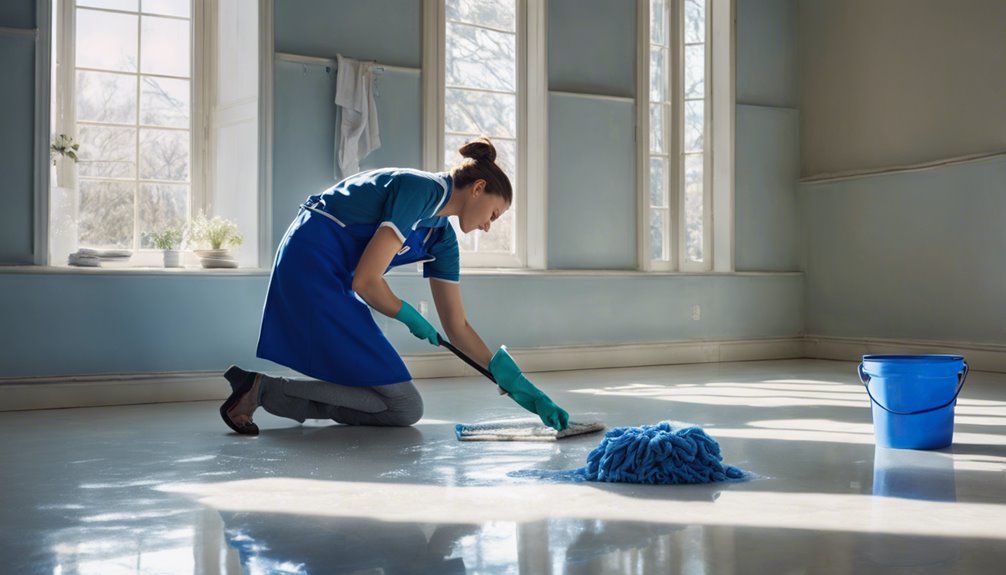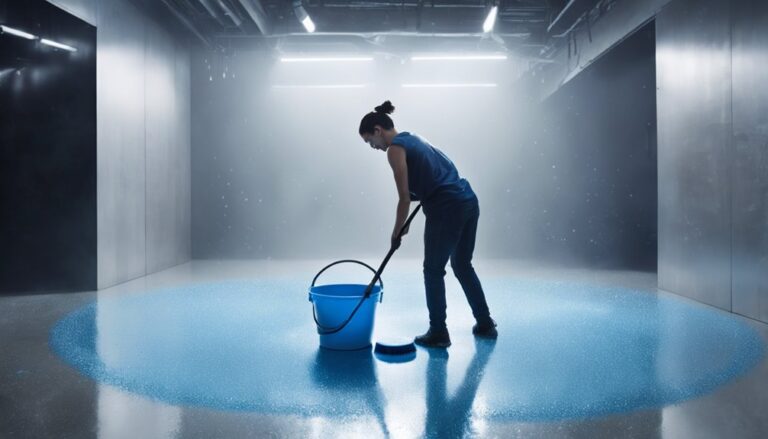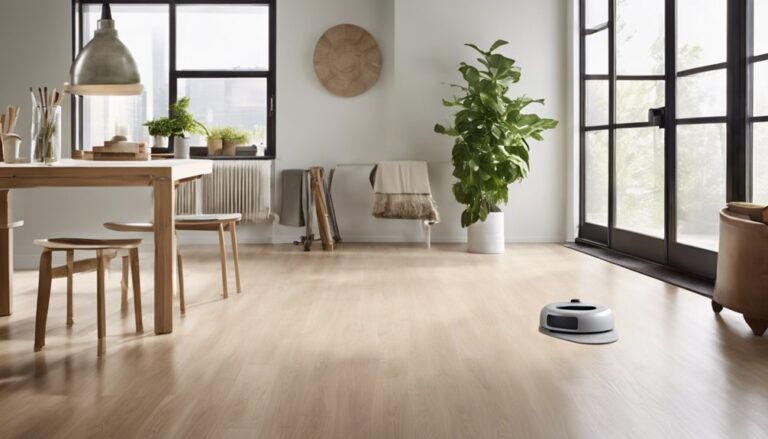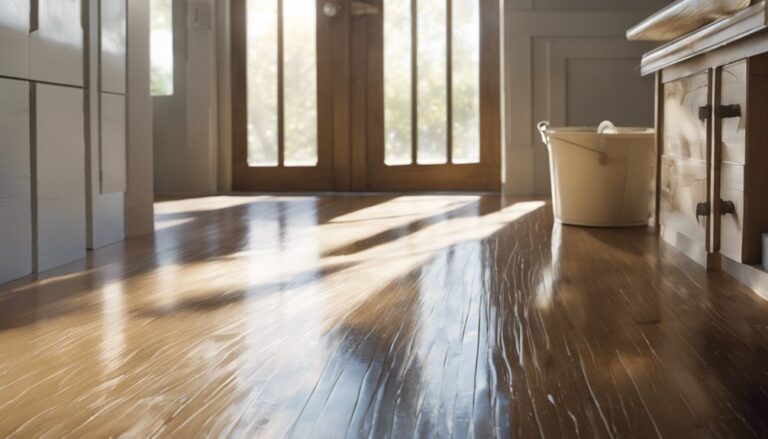To clean porcelain floors effectively, start by removing all furniture and sweeping or vacuuming the area to eliminate loose dirt. Use a pH-neutral cleaner mixed with warm water, and mop the floor in sections, rinsing the mop frequently. For stubborn stains, identify the type and treat accordingly—baking soda paste works well for oil, while a vinegar solution can handle food stains. Always test cleaning solutions on a small area first. After mopping, allow the floor to air dry completely. For more tips on maintaining your porcelain floors' shine and longevity, you can explore additional insights.
Understanding Porcelain Floors
Porcelain floors are a popular choice for many homeowners due to their durability and aesthetic appeal. When selecting tile types, you'll find that porcelain offers a range of designs, from rustic to modern, allowing you to express your unique style. One standout feature is the glossy finish that adds a touch of elegance to any space while reflecting light beautifully. This finish not only enhances the visual appeal but also makes cleaning easier, as dirt and spills are less likely to penetrate the surface. Understanding the different tile types, including glazed and unglazed options, is essential. Glazed tiles provide a higher level of water resistance, making them ideal for kitchens and bathrooms, while unglazed tiles offer a more natural look suitable for living areas.
Essential Cleaning Supplies
To maintain the beauty and integrity of your porcelain floors, having the right cleaning supplies on hand is important. Start with quality cleaning tools, like a microfiber mop and soft-bristle broom, to effectively remove dust and debris without scratching the surface. A pH-neutral cleaner is essential; it won't damage the glaze while providing a deep clean. Consider using maintenance products like a specialized porcelain floor cleaner for tougher stains. Additionally, a bucket, sponge, and soft cloths will help you tackle spills promptly. Don't forget rubber gloves to protect your hands. With these supplies ready, you'll guarantee your porcelain floors stay stunning and well-maintained, allowing you the freedom to enjoy your space without worry.
Daily Maintenance Tips
Since maintaining the beauty of your floors is essential, establishing a daily cleaning routine can make all the difference. Start with daily vacuuming to remove dust and debris, preventing scratches and buildup. Use a vacuum with a soft brush attachment to protect the surface of your porcelain tiles. Following this, incorporate routine mopping into your schedule. A damp mop with a mild, pH-neutral cleaner will keep your floors shiny without damaging the finish. Make certain to avoid excess water, which can seep into grout lines and cause issues over time. By committing to these simple tasks, you'll guarantee your porcelain floors remain vibrant and inviting, allowing you the freedom to enjoy your space without worry.
Removing Stubborn Stains
While routine cleaning helps maintain your porcelain floors, stubborn stains can still pose a challenge. For effective stain removal, first identify the type of stain—whether it's oil-based, ink, or food residue. Once you've determined this, choose an appropriate cleaning solution. For oil stains, a mixture of baking soda and water can work wonders; apply it directly and let it sit for about 15 minutes. For ink or food stains, a diluted vinegar solution can be effective. Always test your cleaning solution in a small, inconspicuous area first to ascertain it won't damage the finish. Gently scrub the stained area with a soft cloth or sponge, rinsing thoroughly afterwards. This methodical approach will help restore your floors to their pristine state.
Deep Cleaning Techniques
Deep cleaning your porcelain floors at least once every few months can greatly enhance their appearance and longevity. To get started, consider using a steam cleaner. This method effectively removes dirt and grime without harsh chemicals, making it an eco-friendly solution. Simply fill your steam cleaner with water, allow it to heat, and then glide it over the surface.
For tougher areas, you can create a solution using vinegar and water—another eco-friendly option. Mop the floors with this mixture, letting it sit for a few minutes before rinsing with clean water. Always test any cleaning solution in a small area first. By incorporating these deep cleaning techniques, you'll maintain your floors' shine and durability, ensuring they look fantastic for years to come.
Avoiding Common Mistakes
When cleaning porcelain floors, it's essential to avoid common mistakes that can lead to damage or dullness. One frequent error is neglecting cleaning frequency; allowing dirt and grime to build up can scratch the surface. Instead, establish a regular cleaning schedule to maintain the shine. Additionally, be wary of harmful chemicals; harsh cleaners can degrade the finish and cause discoloration. Opt for pH-neutral solutions specifically designed for porcelain. Using abrasive tools, like steel wool, is another pitfall—these can leave scratches. Finally, avoid excessive water, as pooling can create a slip hazard and damage grout. By steering clear of these mistakes, you'll keep your porcelain floors looking pristine and vibrant for years to come.
Sealing and Protecting Floors
To guarantee your porcelain floors remain in top condition, it's important to take into account sealing and protecting them properly. Using effective sealing techniques can help prevent stains and moisture penetration. Start by cleaning your floors thoroughly to remove any dirt or debris before applying a protective coating. Choose a high-quality sealant designed specifically for porcelain, ensuring it's compatible with your floor type. Apply the sealant evenly, following the manufacturer's instructions for best results. Regularly check the integrity of the protective coatings, reapplying as needed to maintain that fresh look. By investing time in sealing and protecting your floors, you'll enjoy the freedom of beautiful, long-lasting porcelain that stands up to daily wear and tear.
Troubleshooting Issues
When it comes to porcelain floors, stains and scratches can be frustrating, but they aren't insurmountable. You'll want to identify the source of the discoloration or damage first, as this will guide your repair approach. Let's explore effective solutions for both stains and surface imperfections to restore your floors to their original beauty.
Stains and Discoloration Solutions
Several common stains and discoloration issues can affect porcelain floors, but identifying the right solution is key to restoring their original beauty. Understanding discoloration causes, like spills or prolonged exposure to sunlight, will help you take preventive measures. Here are some stain prevention tips and solutions:
| Stain Type | Solution | Prevention Tip |
|---|---|---|
| Food and Beverages | Clean with vinegar solution | Wipe spills immediately |
| Pet Urine | Use enzyme cleaner | Train pets to go outside |
| Grease | Apply baking soda paste | Use mats in heavy traffic areas |
| Ink | Rubbing alcohol | Avoid writing on floors |
| Mold and Mildew | Bleach solution | Keep areas well-ventilated |
Scratches and Damage Repair
Scratches and damage can mar the sleek surface of your porcelain floors, but you don't have to live with them. For scratches repair, start by using a porcelain repair kit, which typically includes a filler and color-matching glaze. Clean the area thoroughly, then apply the filler as directed, smoothing it over the scratch. Allow it to dry completely before polishing the surface.
To prevent future damage, consider placing felt pads under furniture legs and using area rugs in high-traffic areas. Regular maintenance, like sweeping and mopping, will also help minimize scratches. By taking these steps, you'll keep your porcelain floors looking pristine and enjoy the freedom of a beautiful, damage-free surface.
Maintaining Shine and Luster
To maintain the shine and luster of your porcelain floors, it is essential to adopt a consistent cleaning routine. Start by sweeping or vacuuming regularly to remove dirt and debris, which can dull the surface. For shine maintenance, use a pH-neutral cleaner diluted in water; avoid harsh chemicals that can strip the finish. Mop the floor using a microfiber mop, ensuring you cover all areas evenly. For luster preservation, consider applying a porcelain-safe floor polish every few months. This not only enhances shine but also provides a protective layer against wear. Finally, place mats at entry points to minimize tracked-in grime, keeping your floors looking pristine and free. Regular care will allow you the freedom to enjoy your beautiful floors.
Frequently Asked Questions
Can I Use a Steam Mop on Porcelain Floors?
You can use a steam mop on porcelain floors, but there are benefits and drawbacks to evaluate. The steam mop effectively sanitizes and removes dirt without chemicals, giving you freedom from harsh cleaning agents. However, excessive heat might damage grout over time, so it's important to monitor the temperature settings. Regularly check for any wear or discoloration on your tiles to guarantee they stay in top shape while enjoying the convenience of steam cleaning.
Are There Any Specific Cleaners to Avoid?
Did you know that using harsh chemicals can damage surfaces and potentially reduce their lifespan by up to 50%? When cleaning porcelain, steer clear of cleaners that contain acid or bleach, as they can cause discoloration. Also, avoid abrasive tools like steel wool, which can scratch the surface. Instead, opt for gentle, pH-balanced cleaners to maintain the beauty of your floors while ensuring they remain durable and long-lasting.
How Often Should I Deep Clean My Porcelain Floors?
When it comes to cleaning frequency, you should aim for a deep clean every few months, depending on your lifestyle. Daily maintenance is key; sweeping or vacuuming regularly helps prevent dirt buildup. If you have pets or kids, you might want to deep clean more often. Keeping a schedule will give you that freedom to enjoy your space without worrying about grime. Remember, consistency is essential for maintaining the beauty of your floors!
Will Porcelain Floors Scratch Easily From Furniture?
You might think your porcelain floors are invincible, but they can scratch if you're not careful. To protect your beautiful surfaces from furniture, always use furniture pads. These simple, yet effective, floor protection tools can prevent scratches and dents from heavy items. It's a small effort that gives you the freedom to rearrange your space without worry. Just remember, a little precaution goes a long way in preserving your floors' shine and integrity.
Can I Use Vinegar to Clean Porcelain Tiles?
You can definitely use vinegar to clean porcelain tiles. Vinegar benefits include its natural ability to cut through grime and disinfect surfaces. Just mix equal parts vinegar and water in a spray bottle, then apply it to the tiles. Let it sit for a few minutes before wiping it away with a soft cloth. This method's safe and effective, giving you the freedom to maintain your porcelain tiles without harsh chemicals.




